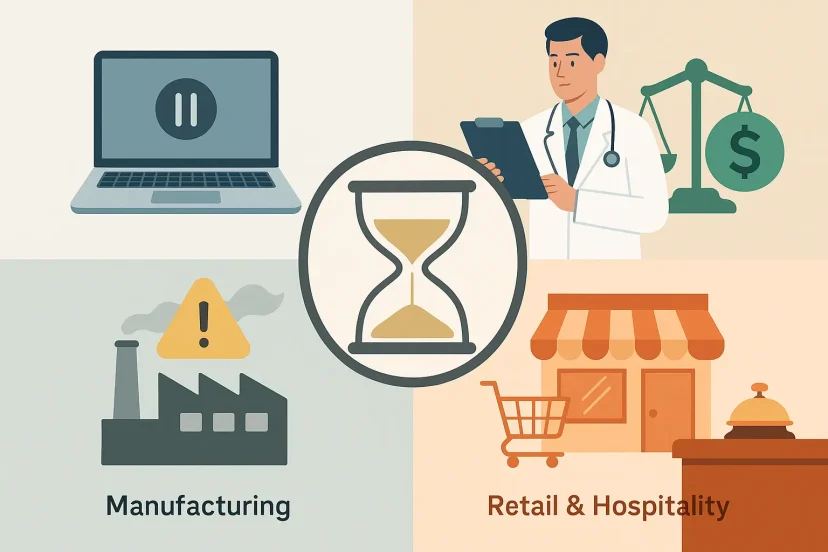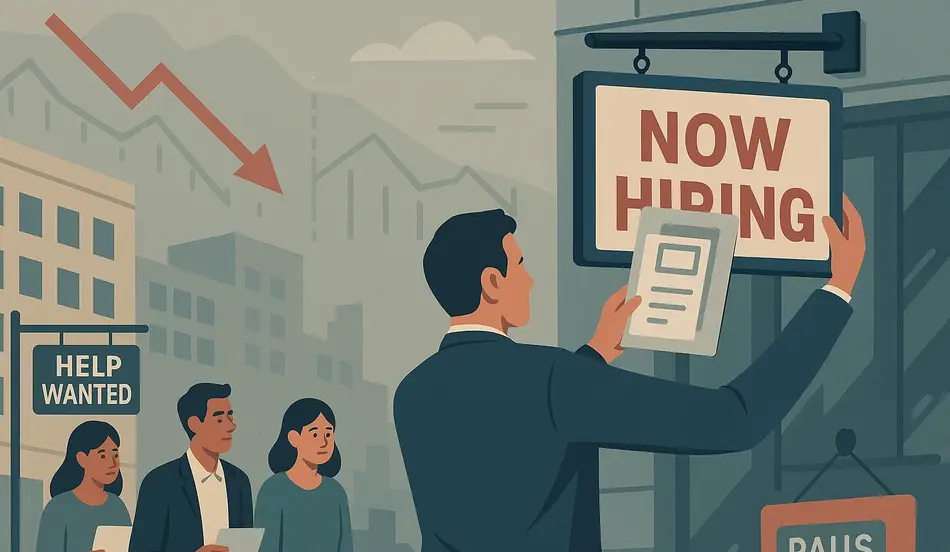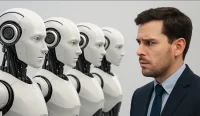Hiring Slowdown 2025 is shaping the U.S. job market. Unemployment remains low, layoffs are rare, and consumer spending is still strong. However, behind the headlines, businesses are becoming more cautious and reducing their pace of new hires.
A new survey reveals that 1 in 5 U.S. companies plan to slow down hiring in the second half of 2025 almost double the share compared to last year. While layoffs are not increasing, the drop in job openings could limit growth and reduce opportunities for workers. Economists warn that this hiring slowdown 2025 may lead to slower economic progress and fewer opportunities for both employers and job seekers.
The paradox is clear: the United States is not in a jobs crisis, but it is inching toward one.
Table of Contents
The Numbers Behind the Trend
- Hiring Slowdowns: Roughly 20% of Chief Human Resource Officers report that their companies will reduce or freeze hiring between now and year-end. That’s the second consecutive year of hiring pessimism.
- Job Growth Revisions: Recent data revisions show that earlier job gains in 2025 were weaker than initially reported. Monthly job creation has averaged closer to 35,000 positions, far below the pre-pandemic average of more than 150,000.
- Unemployment vs. Participation: The unemployment rate is holding steady around 4.3%. But this figure only measures people actively looking for work. Labor force participation has quietly slipped, reflecting discouraged workers and early retirements.
- Low-Hire, Low-Fire Equilibrium: Economists describe the situation as unusual—businesses aren’t laying off in droves, but they also aren’t hiring aggressively. The labor market is stagnant rather than dynamic.
Stand Out in a Stagnant Job Market
Post your job on WhatJobs and reach motivated candidates—even as hiring slows, connect with talent eager to rejoin the workforce and make an impact.
Post a Job Now →Why Companies Are Slowing Hiring
1. Economic Uncertainty
Trade disputes, ongoing tariff escalations, and unpredictable monetary policy have created a cautious corporate environment. Employers are hesitant to expand headcount when future demand and input costs are so difficult to forecast.
2. Automation and AI
AI and automation are reshaping employer calculations. Many executives fear over-hiring now, only to automate roles in the near future. As a result, they prefer to “wait and see,” stretching existing employees instead of bringing in new hires.
3. Policy and Regulation
Recent federal policy shifts—including changes to immigration, healthcare, and labor law—have left businesses unsure of future labor costs. Half of surveyed HR leaders cite government policy uncertainty as a key factor in their hiring hesitancy.
4. Wage and Benefit Pressures
Although wage growth has slowed from its post-pandemic highs, it remains elevated in certain sectors such as healthcare, logistics, and professional services. Employers are reluctant to lock in long-term payroll costs at a time of margin pressure.
Industry Breakdown: Who’s Pulling Back in the Hiring Slowdown 2025
- Tech: After aggressive hiring through 2021–2022 and waves of layoffs in 2023, big tech firms are now cautious. Meta, for instance, has imposed hiring freezes in several divisions despite surging profits from AI initiatives.
- Healthcare: Hospitals and clinics face high demand but also high labor costs. Many are postponing expansion and relying more on overtime or contract staff.
- Manufacturing: With global supply chains in flux and tariffs raising costs, manufacturers are cautious about onboarding workers until demand stabilizes.
- Retail and Hospitality: These sectors are still hiring, but at a slower pace. Seasonal hiring projections for the holidays are already lower than historical averages.

The Bigger Economic Picture
A Fragile Balance
The U.S. job market is balanced precariously between stability and slowdown. While unemployment remains low, job creation is not keeping pace with population growth or labor force needs. Economists worry that even a small uptick in layoffs could tip the system into recessionary conditions.
Productivity and Innovation Risks
Hiring slowdowns don’t just affect workers—they hinder corporate innovation. When companies freeze headcount, they often cut back on training, research, and experimentation. That may shield short-term profits but reduces long-term competitiveness.
Impact on Households
For workers, slower hiring translates into fewer opportunities for advancement and lower bargaining power. Job changes are typically when employees secure their largest pay increases. A slowdown limits wage mobility and entrenches inequality.
Federal Reserve and Policy Reactions
Fed Chair Jerome Powell recently acknowledged the “curious” nature of today’s labor market—resilient yet sluggish. Some officials argue that soft hiring trends justify rate cuts to stimulate economic activity. Others warn that loosening policy could reignite inflation.
On Capitol Hill, lawmakers are divided. Some call for targeted tax incentives to encourage hiring, particularly for small businesses and startups. Others argue that the private sector needs certainty more than subsidies—clarity on tariffs, healthcare costs, and immigration policy may do more to unlock hiring than temporary stimulus.
Historical Context
This isn’t the first time the U.S. has faced a “job market pause.”
- Early 1990s: Coming out of recession, companies were slow to add jobs despite GDP growth, creating the so-called “jobless recovery.”
- Post-2008: Hiring hesitated for years after the financial crisis, leaving millions sidelined and wage growth suppressed.
- 2020–2021: The pandemic created both record layoffs and record rehirings, but volatility eventually gave way to fatigue, with many businesses pulling back once demand normalized.
The current slowdown bears resemblance to those periods: economic growth remains positive, but companies are hedging their bets by conserving labor.
What Experts Are Saying
- Economists: Many see warning signs. “The labor market is flatlining,” one senior economist said. “We’re not in crisis, but we’re also not building momentum. That’s dangerous for long-term growth.”
- Employers: HR chiefs emphasize uncertainty. “We don’t want to be caught overstaffed in six months,” noted a manufacturing executive.
- Workers: Job seekers report more ghosted applications, longer hiring processes, and increased competition for fewer openings.
Potential Paths Forward
- Policy Stability: Clarity on tariffs, labor law, and immigration could reduce uncertainty and encourage hiring.
- Targeted Incentives: Tax breaks or credits for companies that expand headcount in key industries could stimulate momentum.
- Upskilling Workforce: Investing in training for high-demand roles may help employers fill gaps without overextending budgets.
- AI Integration with Human Growth: Encouraging companies to balance automation with human capital investment could prevent over-correction.
FAQs
Q1: Why are companies slowing hiring now if the economy isn’t in recession?
Because uncertainty is high. Trade policies, automation, and elevated wage costs make companies cautious. They prefer to maintain stability rather than risk over-expansion.
Q2: Does slower hiring mean layoffs are coming?
Not necessarily. The current environment is described as “low-hire, low-fire.” Layoffs remain low, but job creation is also muted. However, this equilibrium is fragile—any uptick in layoffs could destabilize the market.
Q3: Which workers are most affected?
New graduates, job switchers, and those in industries like tech and healthcare feel the slowdown most. These groups face fewer openings and longer hiring timelines.
Q4: How could policymakers respond?
Options include interest rate cuts by the Federal Reserve, targeted tax incentives, or immigration and regulatory reforms to stabilize labor costs.
Conclusion
The U.S. job market is at a crossroads. While unemployment remains low and layoffs subdued, fewer companies are bringing in new workers. The hiring slowdown may not yet be a crisis, but it represents a hidden risk—a gradual weakening of momentum that could leave the economy vulnerable to even small shocks.
For workers, it means fewer opportunities to grow and negotiate higher pay. For employers, it means walking a tightrope between stability and stagnation. And for policymakers, it means finding ways to encourage confidence and expansion without reigniting inflation.
America is not in a “jobless recovery,” but it is in a job-shy economy—one where caution reigns, opportunity narrows, and the path forward depends on whether business leaders and policymakers can restore confidence in the labor market.




